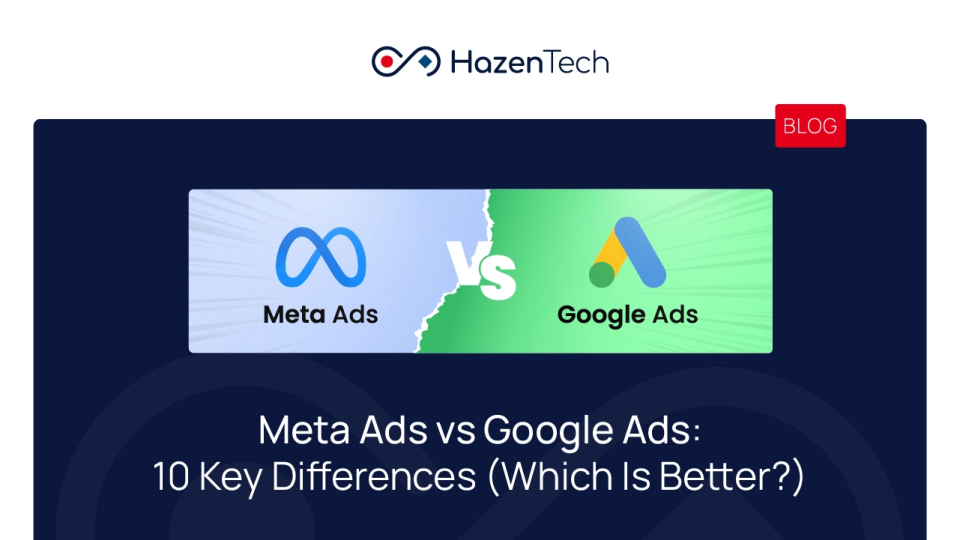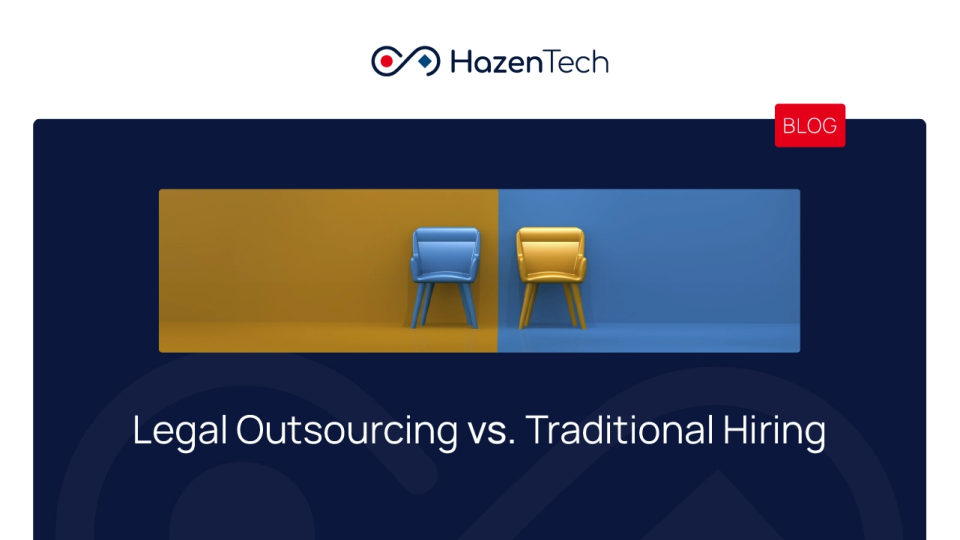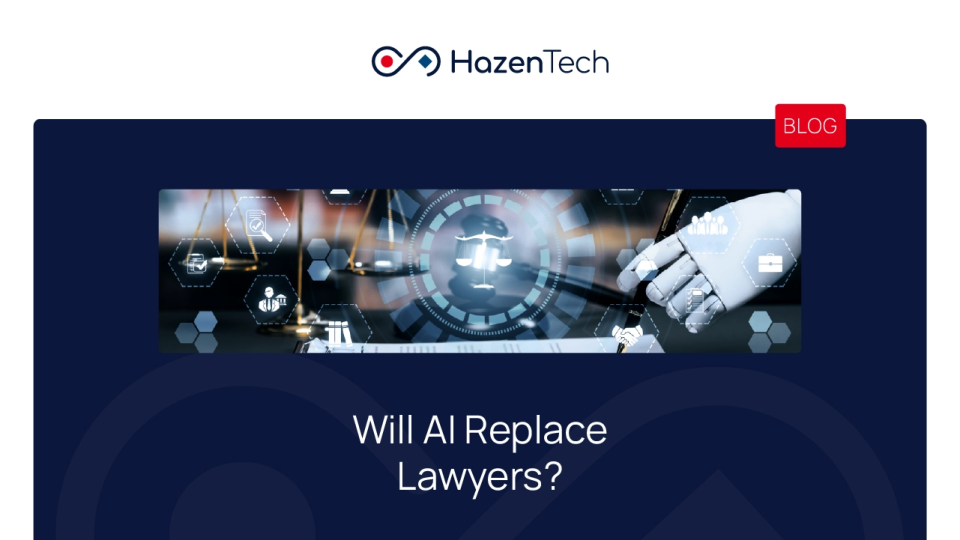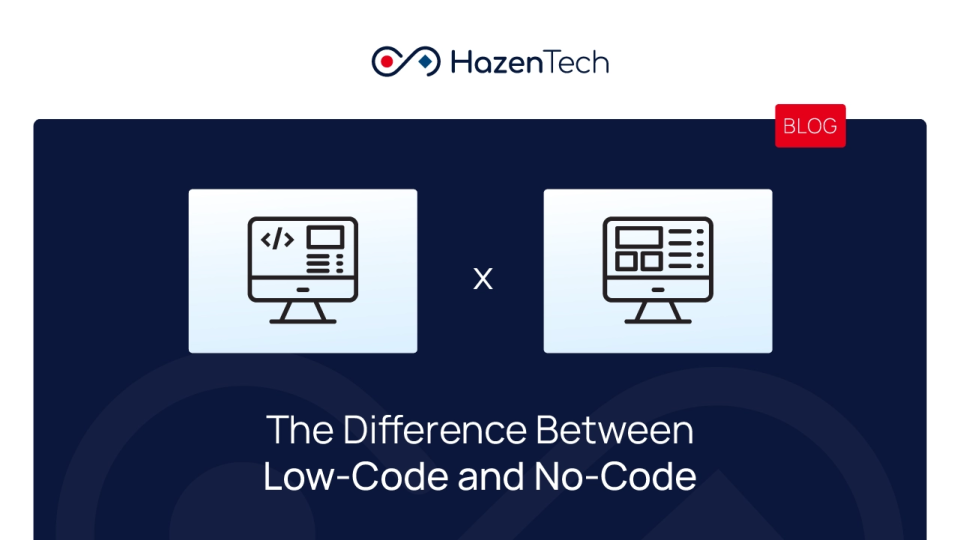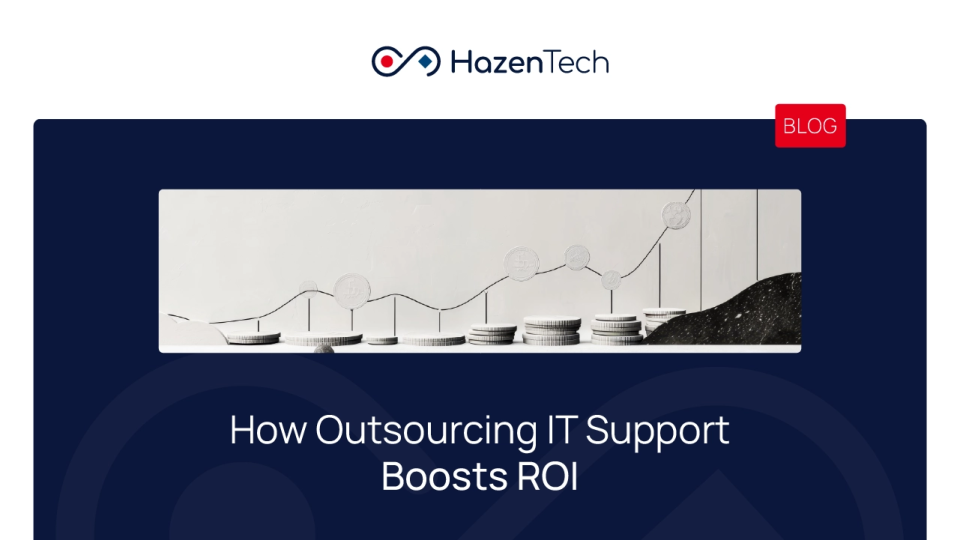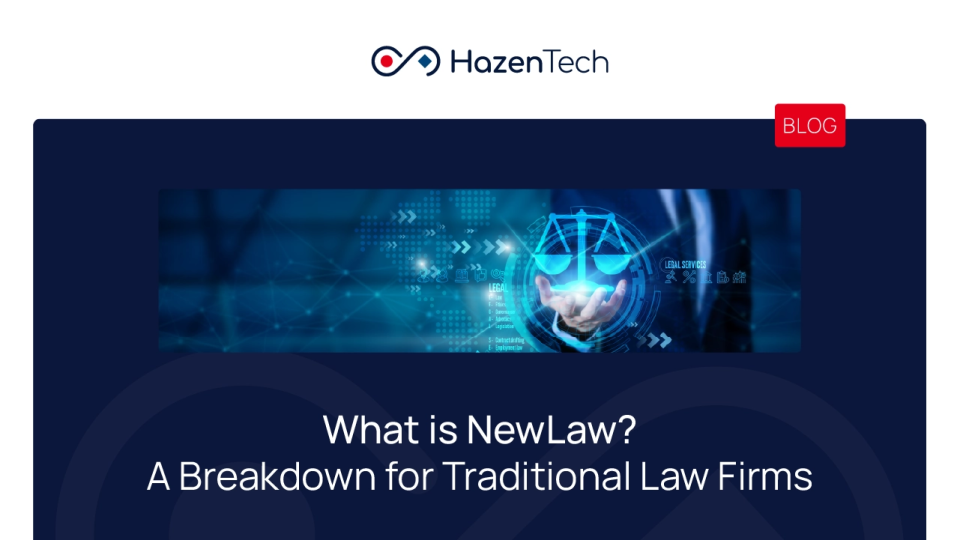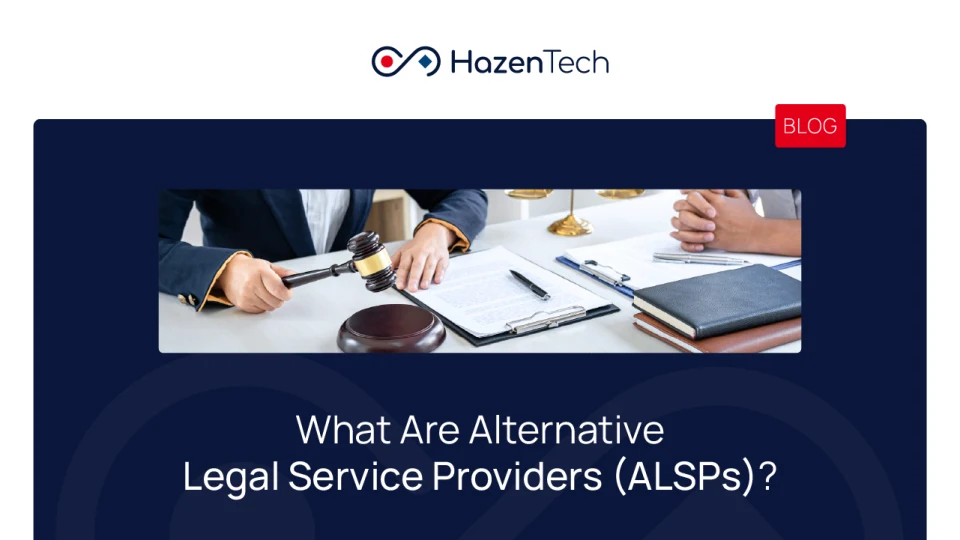A while ago, I started noticing a growing trend towards using Google Ads. As a digital marketing manager, this, obviously, made me curious, and I wanted to dive deeper into the nitty-gritty. I jumped on Google Trends, applied filters, and compared Google Ads with Meta Ads.
Google Trends Comparison Analysis
Worldwide Comparison
Here’s what I found:
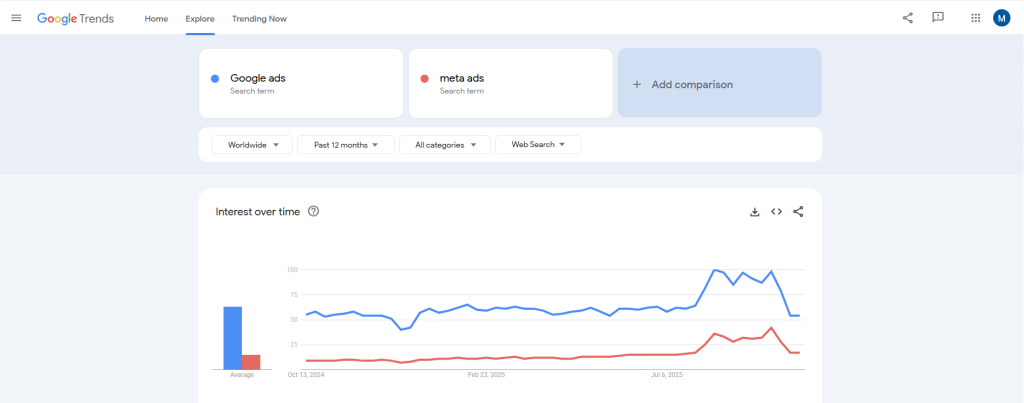
This Google Trends graph compares the worldwide search interest between Google Ads (blue line) and Meta Ads (red line) over the past 12 months.
Here’s a technical breakdown of what it shows:
1. Overall Popularity:
Google Ads consistently maintains a significantly higher search interest than Meta Ads throughout the year. Its average interest level remains above 50 (on a 0–100 scale). While Meta Ads, on the other hand, stays below 15 for most of the period.
2. Trend Stability:
Between October 2024 and mid-2025, Google Ads shows relatively stable performance with minor fluctuations. Now, this shows a steady global demand and awareness for the platform.
3. Spike in Mid-2025:
Around June to August 2025, both terms show a noticeable increase in search activity. Google Ads peaks near 100, while Meta Ads also rises modestly. This sudden heightened interest is likely linked to product updates, marketing events, or advertising seasonality during that period.
4. Post-Spike Decline:
After August 2025, both queries experience a decline. However, Google Ads remains dominant and ends the period around an index of 50. Meta Ads stabilizes around 10–15, showing it still trails far behind in relative search volume.
5. Average Comparison:
The left-side bar chart visually confirms this gap: average interest for Google Ads is roughly four to five times higher than for Meta Ads. No wonder I’ve been observing more client interest towards Google Ads.
Here’s a simpler comparison table:
Factor | Google Ads | Meta Ads | Insights |
Search Interest (Worldwide, 12 months) | Very High (70–100) | Moderate (10–30) | Global demand for Google Ads far exceeds Meta Ads. |
Trend Stability | Strong and consistent | Slight growth in recent months | Meta Ads are gaining mild traction globally. |
Peak Period | June–August 2025 | August 2025 | Both peaked mid-year, with Google maintaining dominance. |
Average Interest | ~3× higher than Meta | — | Google Ads retains global relevance and authority. |
Market Visibility | Established leader | Secondary but growing player | Advertisers still trust Google for reach and ROI. |
Comparison in United States
This Google Trends graph compares Google Ads (blue) and Meta Ads (red) search interest in the United States over the past 12 months.
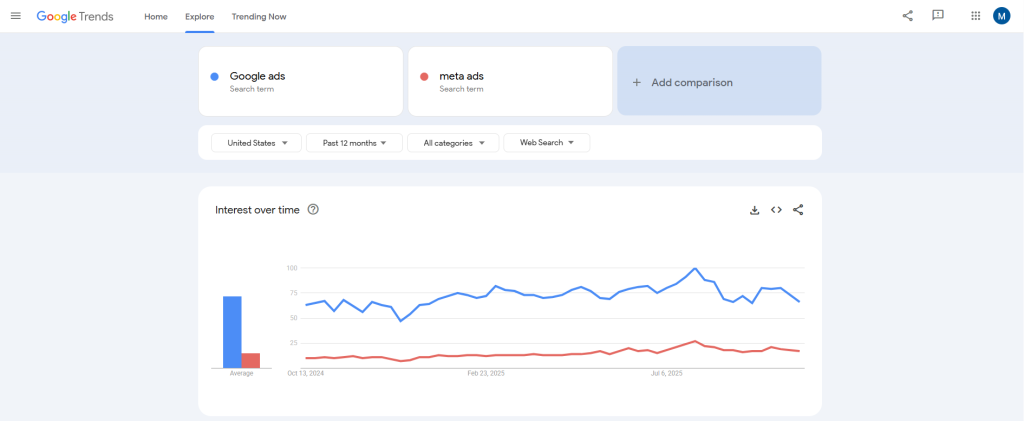
Here’s a technical analysis
1. Overall Trend:
Google Ads maintains a significantly higher search interest throughout the year in the United States. Its trend line consistently ranges between 55 and 80, while Meta Ads remains low, between 5 and 20.
2. Stability:
Google Ads shows stable interest with minor fluctuations. This shows that Google Ads has a mature and quite consistent user base. The steady volume implies that Google’s ad platform remains a primary choice among advertisers.
3. Meta Ads Growth:
Meta Ads may have lower user interests, but it shows a slight upward trend mid-year (around June–July 2025), possibly linked to Meta’s product updates or marketing pushes for AI-based ad placements.
4. Peak Activity:
Around July 2025, both platforms see small spikes in search volume, likely reflecting seasonal ad campaigns or industry events.
5. Relative Comparison:
The bar graph on the left visually confirms the disparity: average U.S. search interest in Google Ads is roughly four times higher than in Meta Ads. So, yes, Google has led in market visibility and advertiser attention.
Here’s a simpler comparison table:
Factor | Google Ads | Meta Ads | Insights |
Search Interest (US, 12 months) | High (55–80) | Low (5–20) | Google Ads dominates user attention. |
Trend Stability | Consistent | Slight upward trend | Google has steady interest; Meta is slowly growing. |
Peak Period | July 2025 | July 2025 | Both saw mild spikes mid-year. |
Average Interest | ~4× higher than Meta | — | Indicates Google’s stronger brand recall and demand. |
Market Visibility | Mature and trusted | Emerging and developing | Google remains the go-to platform for advertisers. |
Quick FAQ:
So, should we stop Meta Ads?
No! Social media holds 5.41 billion users. That means 65.7% of the world’s population uses social media. Google Ads may have a higher interest, but it doesn’t rule out the fact that both platforms have their own strengths, audiences, and intent-driven advantages. Google captures people ready to buy; Meta reaches people ready to discover.
10 Key Differences Between Meta Ads and Google Ads
PPC management services use different platforms for different purposes, and that’s a complexity that needs to be addressed. I’ve observed 10 key differences between Meta Ads and Google Ads from personal experience, and I’m going to share of those to help you make a better decision.
- Campaign Objectives & Setup Flexibility
- Ad Placement Ecosystem
- Audience Targeting & Data Depth
- User Intent vs. Audience Discovery
- Creative Strategy & Ad Formats
- Algorithm & Learning Phase Behavior
- Cost Structure & Bidding Models
- Attribution & Conversion Tracking
- Reporting & Analytics Tools
- Scalability & Automation Potential
Meta Ads Vs Google Ads: Campaign Objectives & Setup Flexibility
When you set up an ad campaign, whether it’s Meta or Google, the first thing you need to do is define the objectives. Now what does that mean? You see, not every ad is created to sell a product, raise awareness, or promote certain news. So, your objective defines the process ahead.
Both Meta and Google claim to make this step “simple,” but in practice, the logic behind each platform’s structure is completely different. On top of that, it impacts how much control you have over your campaign.
Meta Ads
In Meta Ads Manager, the campaign objective is the campaign type. That means when you select “Traffic,” “Leads,” or “Sales,” you’re essentially locking in a campaign framework that includes optimization events, delivery systems, and ad format eligibility.
Meta’s algorithm optimizes the campaign very precisely around that chosen goal. For example, a “Leads” campaign will behave very differently from a “Traffic” campaign, even if the ad creatives and targeting are identical.
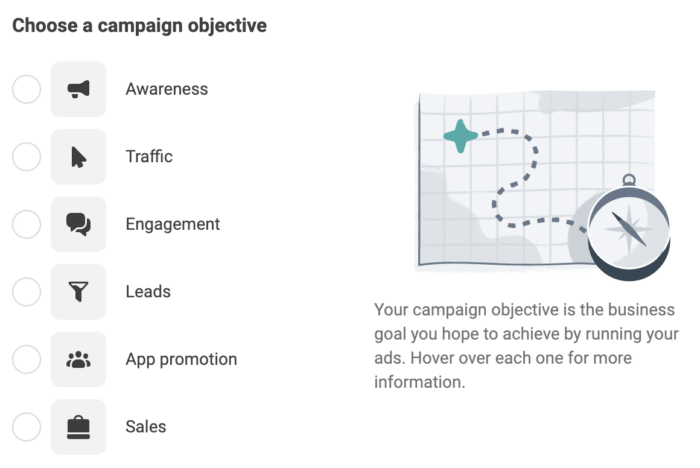
Google Ads
On the other hand, adding objectives is optional on Google Ads. But honestly, I prefer leaving that box unchecked. That’s because when you select an objective like “Brand Awareness” or “Sales,” Google restricts available campaign types in the next step.
For reference, if you check the “Brand Awareness” box, Google limits you to Display or Video campaigns only. But if you skip it, you can choose freely from Search, Display, Performance Max, Discovery, YouTube, and Shopping. So, that’s a more flexible approach overall.
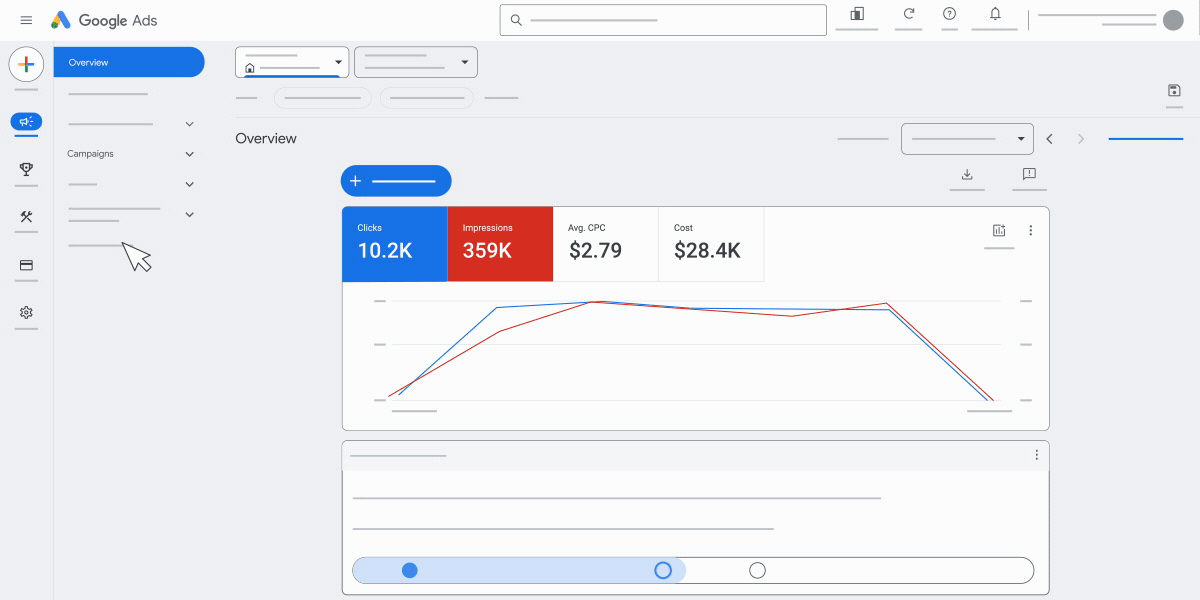
Key Takeaways
My neutral take on this is: Meta’s structure is user-friendly but rigid, while Google’s is technical but modular. Meta helps beginners stay on track; Google rewards those who understand the ecosystem well enough to build without handrails.
Meta Ads Vs Google Ads: Ad Placement Ecosystem
The second aspect to consider when building ad campaigns is the ad’s placement. That’s because where your ad shows often matters more than what it says (Sounds ironic, but trust me, it matters). Both Meta and Google have huge placement networks, but they work very differently.
Meta Ads
Meta placements live across Facebook, Instagram, Messenger, and the Meta Audience Network (MAN). So what’s the Meta Audience Network? It’s a platform which allows advertisers to extend their ads across third-party apps and websites.
One way to run an ad campaign is to allow Meta to decide placements automatically through Advantage+ Placements (which usually gives the best performance early on). The second way is to manually choose where your ads appear, such as Feed, Stories, Reels, or in-stream videos.
Each placement demands a different creative format:
- Feed → square or 4:5 images/videos
- Stories/Reels → vertical 9:16 videos
- In-stream → short, sound-on videos
If you’re a marketer, you can relate with me on this: Audience Network traffic tends to be cheaper, but it’s not always high-quality. So it’s really important to review placement reports to identify where the conversion rate is the highest.
Source: Meta Ads Manager
Google Ads
Google’s placement system is much broader. Your ads can appear on:
- Search results
- YouTube (in-stream, shorts, discovery)
- Display Network (millions of partner sites)
- Gmail and Discover feeds
- Google Maps and Shopping tabs
Unlike Meta, Google placements extend far beyond Google-owned platforms. Shout out to the Google Display Network (GDN) and AdX, which cover huge parts of the open web. You can either let Google automatically distribute ads through Performance Max campaigns or manually control where your ads appear using managed placements.
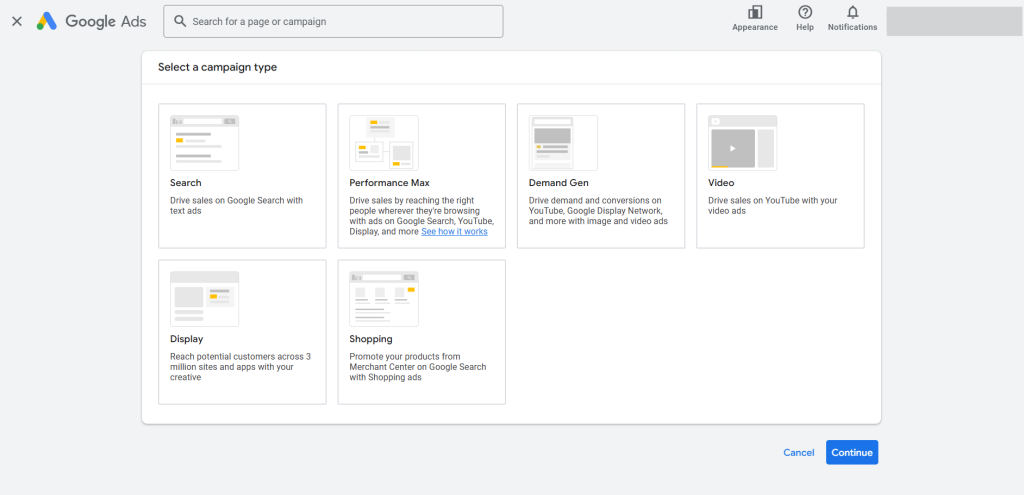
Key Takeaways
Here’s the thing: Meta is way better for visual storytelling and audience-based delivery. Google, on the other hand, dominates intent placements that meet users mid-search. Meta builds reach through people, and Google builds reach through queries and content.
Meta Ads Vs Google Ads: Audience Targeting & Data Depth
Audience targeting is something most advertisers don’t really spend time on, and honestly, that’s often where things mess up. Google and Meta both offer audience targeting features, but it’s worth noting that each platform has its own audience type.
Meta Ads:
Meta has a people-first approach. It builds audiences from user profiles, behavior, and engagement data collected across Facebook, Instagram, and other connected apps. You can target users based on demographics (age, gender, location), interests (fitness, fintech, travel, etc.), or behaviors (like frequent event organizers or online shoppers).
But after Apple’s iOS 14.5 update and tighter privacy laws, Meta lost a significant portion of its third-party tracking capability. That’s where first-party data and Meta’s machine learning now play a significant role.
You can create three main audience types:
- Core Audiences: Based on demographics, interests, and behaviors.
- Custom Audiences: Built from your own CRM, website visitors (via Meta Pixel), or app activity.
- Lookalike Audiences: AI-generated groups that resemble your best-performing customers.
I’ve personally found that the newer Advantage+ Audience (Meta’s automated targeting model) often performs better than manual conversion campaigns.
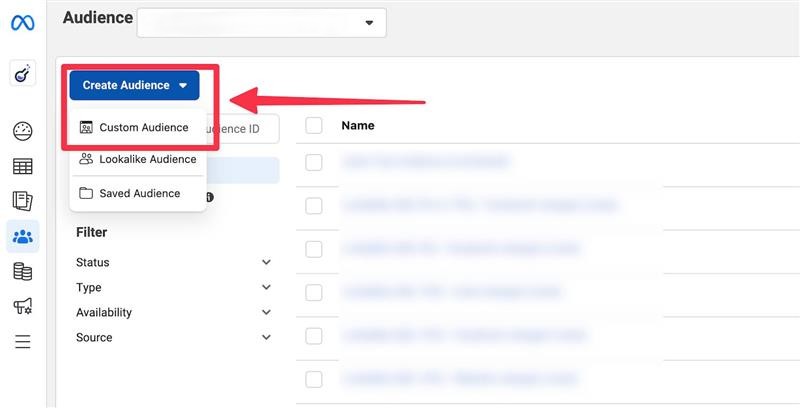
Google Ads:
Google builds audiences using search intent and contextual signals. Every time you search a keyword, watch a YouTube video, or visit websites that share data with Google, the system collects behavioral insights linked to your account. The result? You start seeing ads that match your current interests or purchase intent.
Here’s how targeting works:
- Keyword Targeting: Ads show up for specific search queries.
- In-Market Audiences: Users who are actively researching or ready to buy.
- Affinity Audiences: People with long-term interests, similar to Meta’s Core Audiences.
- Custom Segments: Your own mix of URLs, keywords, or apps that define user intent.
- Customer Match: Uploads of your own data (emails, phone numbers, etc.) for retargeting.
Google’s biggest advantage lies in data depth. It pulls intent signals from YouTube, Search, Maps, Gmail, and millions of partner websites. When you combine keyword-based intent with first-party data through Performance Max, the targeting becomes eerily precise.
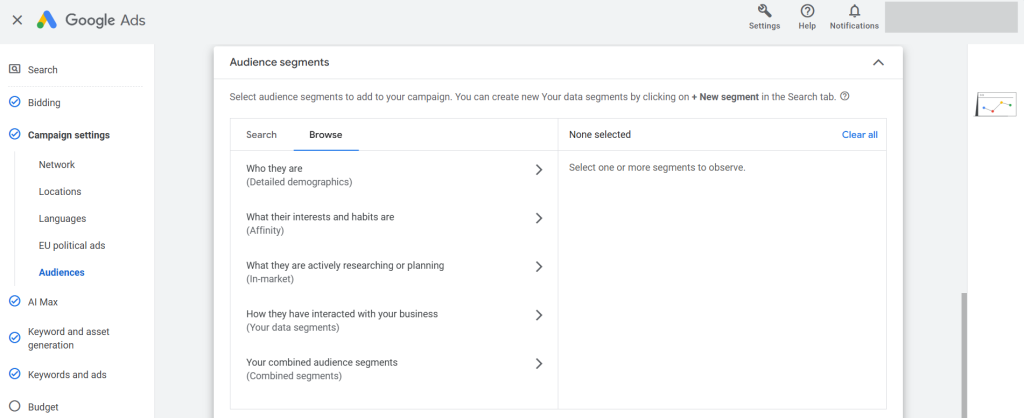
Key Takeaways
Meta targets who people are; Google targets what people want. It’s a very clear and simple difference. You can consider Meta a winner in emotional engagement and community reach. Google has no match when it comes to actionable intent and purchase-readiness.
Meta Ads Vs Google Ads: User Intent vs. Audience Discovery
We’ve discussed user intent in the previous section. Still, I felt like it needed more discussion. That’s primarily because both Meta and Google have a different approach to interpreting human behavior. Google’s focus is on displaying results to hungry customers. Meta is quite a lot about predictions and customer nurturing.
Meta Ads:
Meta, meanwhile, doesn’t rely on explicit intent and instead uses predictive discovery. What’s predictive discovery? It’s an application of predictive analytics that uses data mining and machine learning to discover hidden patterns and predict future outcomes.
Its algorithm studies user engagement patterns to predict what will capture attention next. You might never search for a skincare product, but if you liked a beauty reel, paused on a makeup tutorial, or visited a similar brand’s profile, Meta tags you as a potential skincare buyer.
That’s powered by Meta’s behavioral graph, which maps interests, relationships, and content interactions across Facebook, Instagram, and third-party apps through the Meta Pixel and Conversions API (CAPI).
Where Google reacts to a query, Meta forecasts desire using deep learning models trained on engagement metrics like how long users dwell on a post, what they comment on, and even how fast they scroll past content. That’s how Meta builds lookalike or Advantage+ audiences that behave like your best-performing customers, even if they’ve never heard of your brand.
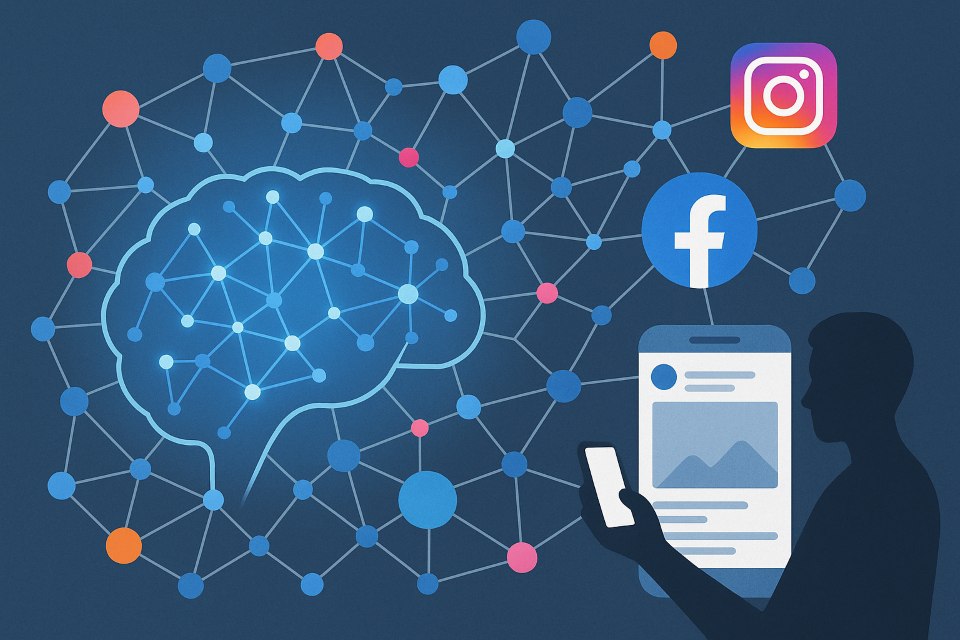
Google Ads:
Google’s foundation is active intent – meaning that it believes in a consumer’s clear and explicit signaling of their interest in a specific product, service, or topic. So, you might have noticed, every ad impression starts with a user-initiated action like a search query, a YouTube watch, a product browse, or an article read. That action triggers Google’s machine learning models, which analyze query relevance, browsing context, historical behavior, and device signals in milliseconds before deciding which ad to serve.
When a user searches “best accounting software for startups,” Google evaluates not just the keyword but also the semantic meaning, the user’s past searches, and even the session journey (what pages they visited earlier). That’s how it knows whether to show a demo ad, a free trial, or a comparison article. Clever, right?
Outside of Search, intent still drives visibility. YouTube, Discover, and Gmail placements rely on contextual intent modeling – meaning Google identifies users with similar viewing or browsing habits, even if they haven’t typed a keyword recently.

Key Takeaways
If someone already knows what they want, Google delivers your ad at the perfect moment of decision. But if they’re still in the “scrolling and exploring” stage, Meta’s predictive system pushes your ad in front of them before they even realize they’re interested.
Meta Ads Vs Google Ads: Creative Strategy & Ad Formats
Creatives are often overlooked, and by overlooked, I don’t mean complete neglect, but rather not strategically considering the thought process. Let me share an example: ever heard of meme marketing? It’s when you combine memes with your ad and produce an entertaining ad that engages users, especially Gen Z.
But of course, creative strategy isn’t the same on Google and Meta. Meta ads compete for attention in a fast-scrolling environment, while Google ads respond to intent in a contextual space.
Meta Ads:
Meta is more centric to visual-first storytelling, where the creative strategy does almost all the heavy lifting. That’s mainly because users aren’t actively searching for products or services; they’re just randomly scrolling. So, you’ve got roughly 1.7 seconds on mobile before they decide whether to stop or keep going.
Here’s the ideal approach:
- Ad Formats: Meta supports single image, carousel, video, collection, Instant Experience (full-screen mobile ads), and Reels. Video content, especially Reels and short vertical clips, consistently gets higher engagement rates than static visuals.
- Dynamic Creative: Meta’s Dynamic Creative feature lets you upload multiple headlines, descriptions, and visuals. Its algorithm tests combinations to find the highest-performing ad variation.
- Aspect Ratios Matter: A 1:1 format works best for Feed, while 9:16 is suitable for Stories and Reels. Meta penalizes creatives that don’t fit the placement frame properly.
- AI-Based Personalization: Meta automatically adjusts ad brightness, contrast, and even text overlays per user using advantage+ Creative.
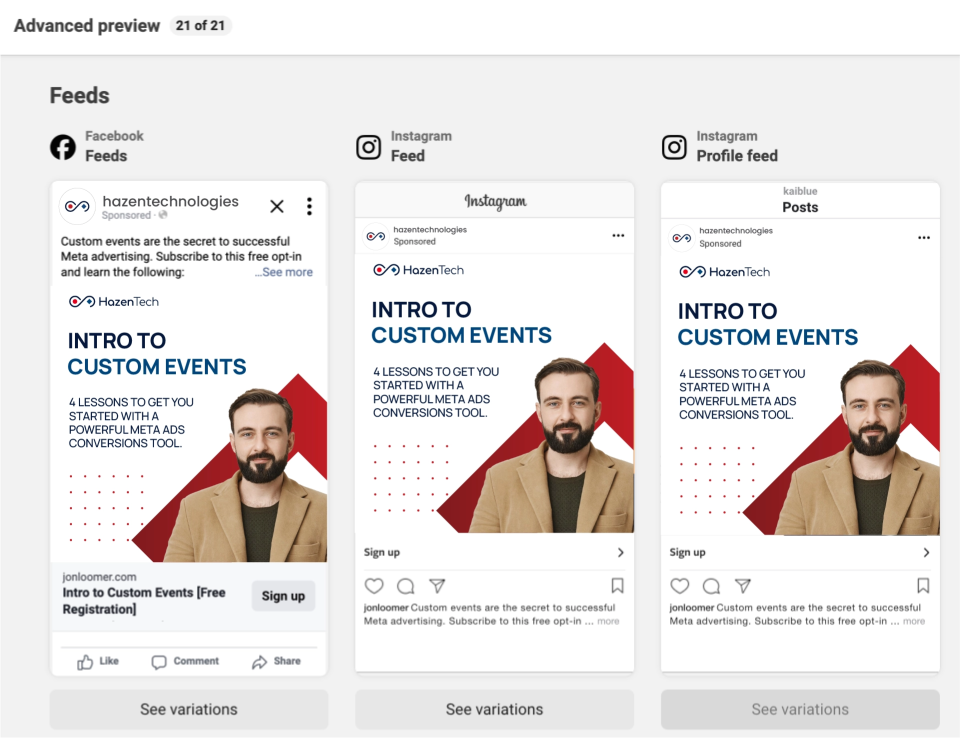
Google Ads:
Google’s creative strategy depends quite a lot on the campaign type. If Meta is more about visuals, Google prioritizes relevance.
- Search Ads: These are text-only campaigns that rely heavily on ad copy structure. This includes headlines, descriptions, and display paths. Responsive Search Ads (RSAs) use machine learning to test multiple headline and description combinations automatically.
- Display Ads: Google Display Network (GDN) supports responsive image ads that auto-adjust to fit website layouts. The system pulls in your assets (logo, image, copy) and resizes them across millions of partner sites.
- YouTube Ads: Like the name suggests, the video you create is the absolute king here. Formats like skippable in-stream, non-skippable, bumper, and in-feed video ads. YouTube also uses Video Action Campaigns, which combine intent signals from Search with video engagement data for higher conversions.
- Performance Max: This is Google’s most automated format, which combines Search, Display, YouTube, Gmail, and Maps placements. It uses asset groups, a mix of images, videos, headlines, and ad copy, and AI determines which asset performs best across each surface.
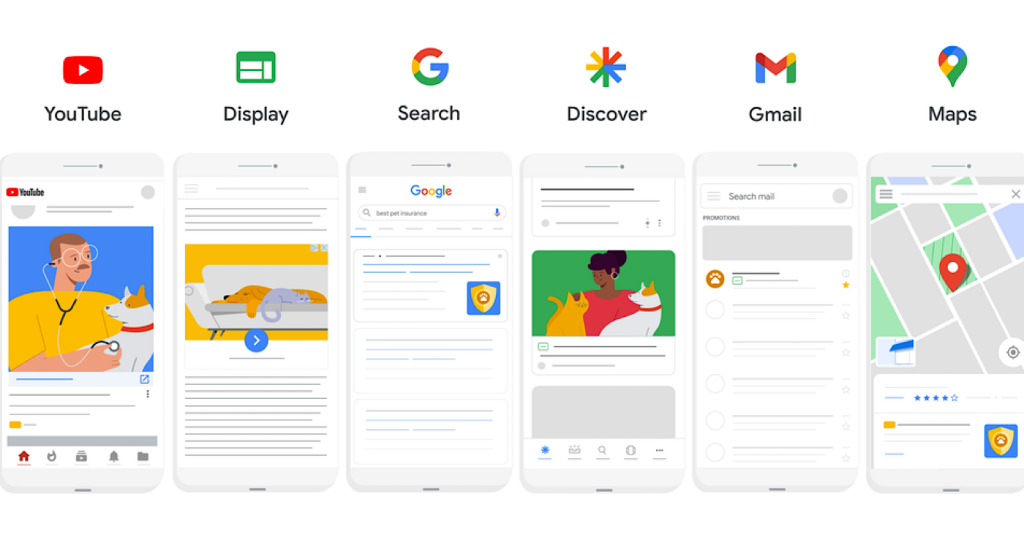
Key Takeaways
Meta’s creative strategy revolves around design. You have to make people feel before they think. Google’s a bit rational and revolves around users’ purchasing clarity. You need to match what users want with words and visuals that confirm their intent.
Meta Ads Vs Google Ads: Algorithm & Learning Phase Behavior
Google and Meta monitor how their algorithms learn user behavior, but that doesn’t mean they work similarly. I’ve managed a lot of campaigns, and I’ve learned that Meta and Google may both be using AI for behavior analysis. If Meta works on behavioral feedback loops, then Google relies on information precision and signal quality.
Meta Ads:
Meta’s algorithm works on pattern recognition – meaning that when a campaign enters its Learning Phase, the system studies how users interact with your ad. These interactions include clicks, scroll stops, reactions, video watch time, and conversions.
To exit the learning phase, Meta needs almost 50 optimization events per ad set within 7 days (for example, 50 conversions if your optimization goal is “Purchases”). Until that threshold is reached, delivery can fluctuate, CPMs may spike, and results can look inconsistent.
So, here’s what’s happening behind the scenes:
- Initial Learning: Meta tests various audience pockets and ad variations to understand response behavior.
- Stabilization: It narrows delivery toward users most likely to take action once it collects enough data.
- Feedback Loop: Performance data from every impression feeds into Meta’s machine learning model (often referred to as its aggregated event measurement system).
Here’s an interesting fact: Meta’s algorithm learns per ad set, not per campaign. That’s one reason why you should avoid making too many edits mid-phase. Surprisingly, a simple budget change or maybe a creative swap can reset learning and erase accumulated data.
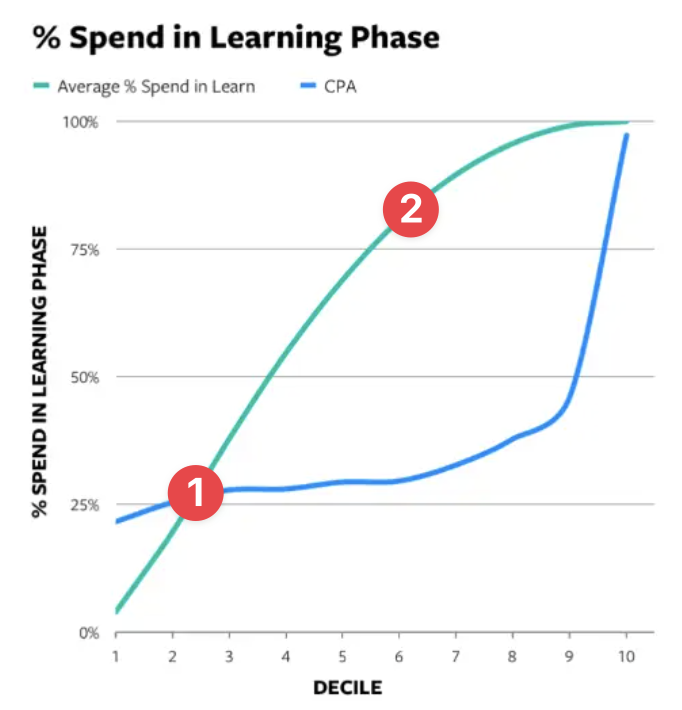
Google Ads:
Google’s algorithm is much more signal-dependent. Instead of studying how users behave socially, it analyzes intent patterns like search queries, click-through behavior, site interactions, and conversion tags.
Google’s learning phase typically requires at least 15–30 conversions in 30 days (depending on campaign type) to stabilize. But unlike Meta, Google’s learning is heavily influenced by data signal quality – meaning your tracking setup, conversion accuracy, and first-party data integrations directly affect how efficiently the algorithm learns.
Here’s how it works:
- Signal Collection: Google aggregates contextual and audience signals (keywords, devices, demographics, time of day).
- Predictive Modeling: Its Smart Bidding system (Maximized Conversions, Targeted CPA, or Targeted ROAS) predicts which auction signals will lead to your desired action.
- Adaptive Optimization: Over time, Google identifies which signal combinations produce the best ROI and adjusts bids accordingly.
Key Takeaways
In simple terms, Meta’s learning feels like intuition refined by repetition, while Google’s feels like logic refined by math. When you plan cross-platform campaigns, you should always let Meta handle discovery first and Google fine-tune conversions later.
Meta Ads Vs Google Ads: Cost Structure & Bidding Models
Meta charges advertisers for impressions, while Google does it for clicks. Meta rewards creative testing and broad optimization, while Google prizes intent-driven precision. But the cost and bidding structure aren’t that simple. It’s not really about setting a budget and launching the campaign. In fact, this could lead to wasting money with zero conversions.
Meta Ads:
Meta’s entire pricing logic revolves around impression-based bidding (CPM). You pay for visibility and not necessarily for clicks or conversions. The algorithm then tries to deliver your ad to users most likely to perform your chosen action (click, lead, or purchase).
You can set your campaign to optimize for:
- Lowest Cost (automatic bidding): Meta uses your budget to achieve the most results at the lowest price.
- Cost Cap: Keeps your average CPA near your target.
- Bid Cap: Gives you control over auction bids but can restrict delivery if bids are too low.
In Meta Ads, your cost per result depends on three factors: audience size, competition, and engagement rate. Meta lets creativity influence cost. If your ads perform well, you’ll literally pay less for attention.
Google Ads:
Google, on the other hand, prices attention by intent strength. You pay for relevant traffic. Each auction weighs your bid amount, ad quality, and expected impact to decide if your ad shows and, if so, then where.
Common bidding models include:
- Maximize Conversions / tCPA: Optimizes for the most conversions within your target cost.
- Target ROAS (tROAS): Focuses on conversion value, ideal for eCommerce.
- Maximize Clicks: Increases traffic volume, usually for top-of-funnel awareness.
CPCs fluctuate depending on keyword competitiveness. High-commercial-intent terms (“personal injury lawyer near me”) are far more expensive than general queries (“legal help”).
Google’s advantage is control — you can adjust bids by device, audience, or location, giving you much tighter control over acquisition costs than Meta.
Key Takeaways
Meta offers more affordable reach but charges for impressions gained. If the traffic needs to be transaction-ready, Google justifies the higher CPC.
Meta Ads Vs Google Ads: Attribution & Conversion Tracking
This is where things get a little tricky because how each platform defines and tracks conversions can totally change how you read your results.
Meta Ads:
Meta’s attribution is not limited to clicks. It includes impressions, engagements, and assisted actions. Meta uses a data-based attribution model based on pixel, Conversions API (CAPI), and cross-device data. For example, if someone sees your ad on Instagram, and decides not to click but later visits your site and buys a product/service, Meta can still count that conversion (depending on your attribution window).
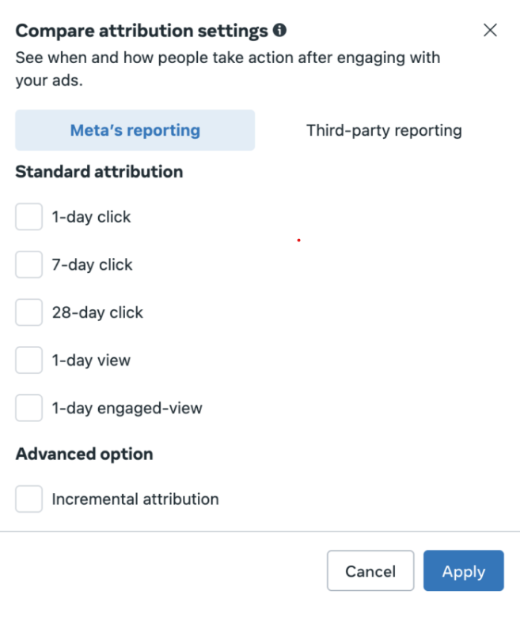
Google Ads:
Google Ads, on the other hand, plays a different game. It relies heavily on intent-driven clicks tracked via Google Tag Manager, global site tags (gtag.js), or enhanced conversions. Its conversion model focuses on click-based attribution, meaning it credits the actual ad interaction that led to the measurable action. For instance, if someone clicks a search ad and converts three days later, Google attributes that conversion to the ad clicked — not the display or video ad they saw before.
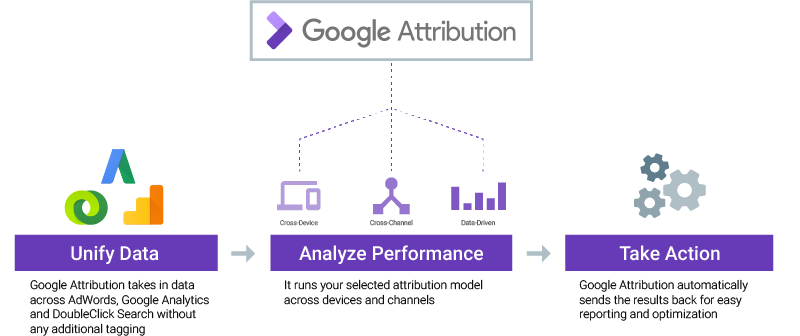
Key Takeaways
So, while Meta helps you measure influence across touchpoints, Google focuses more on intent and direct conversions. Both are powerful, but they tell very different stories about your campaign’s success.
Meta Ads Vs Google Ads: Reporting & Analytics Tools
If you’re really interested in knowing how these tools think, you should observe the reporting process. Although both offer excellent data, their interpretation is different.
Meta Ads:
I often describe Meta Ads as a behavior-driven reporting system. Meta Ads Manager focuses on how users interact with your ads (impressions, engagement rate, reach, and delivery breakdowns) by demographics and placement. You can easily compare performance across Facebook, Instagram, Audience Network, and Messenger, but it’s still somewhat confined within Meta’s ecosystem.
Meta has made solid improvements with tools like Aggregated Event Measurement and Conversions API, especially post–iOS 14, to preserve tracking accuracy. However, there’s still a bit of a “black box” feel because you see what Meta chooses to reveal about delivery and audience behavior.
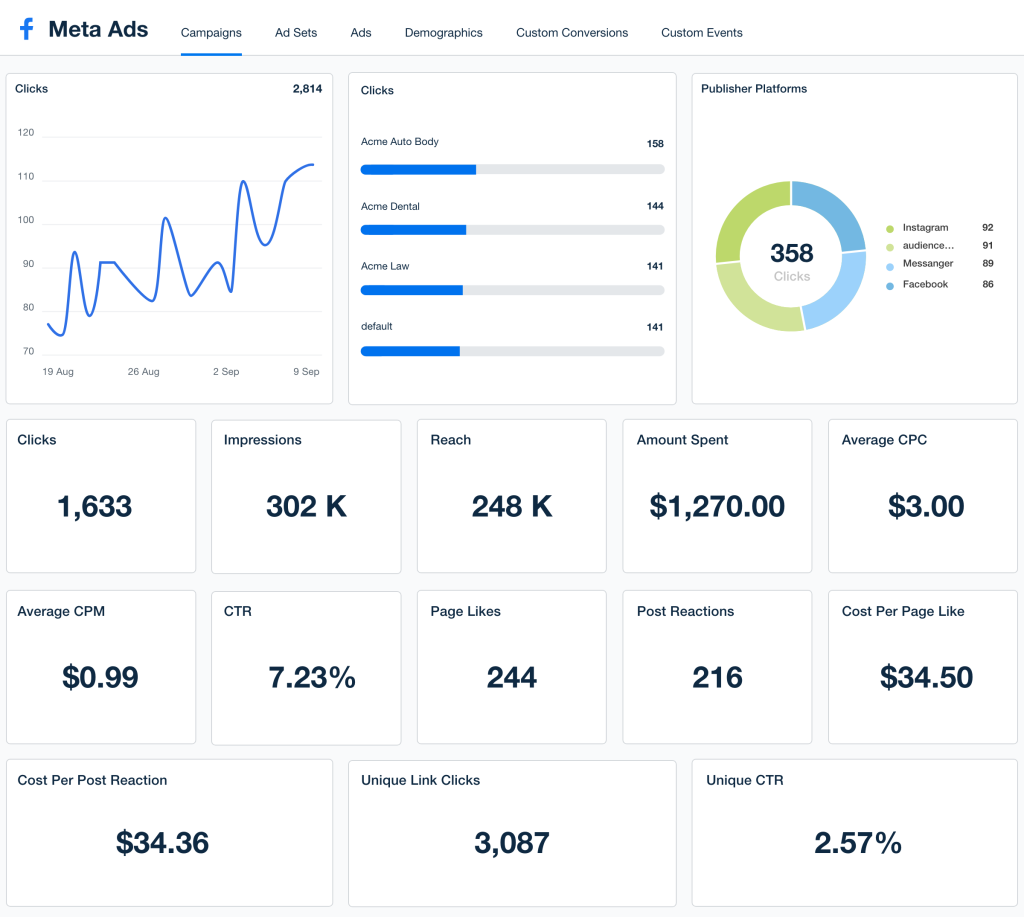
Google Ads:
Google Ads, on the other hand, is obsessed with measurability. It connects with Google Analytics 4 (GA4), Tag Manager, and Data Studio (now Looker Studio) – meaning you can track clicks, sessions, and conversion paths in granular detail. You can even create multi-channel attribution reports that map a user’s journey across Search, Display, YouTube, and external sites.
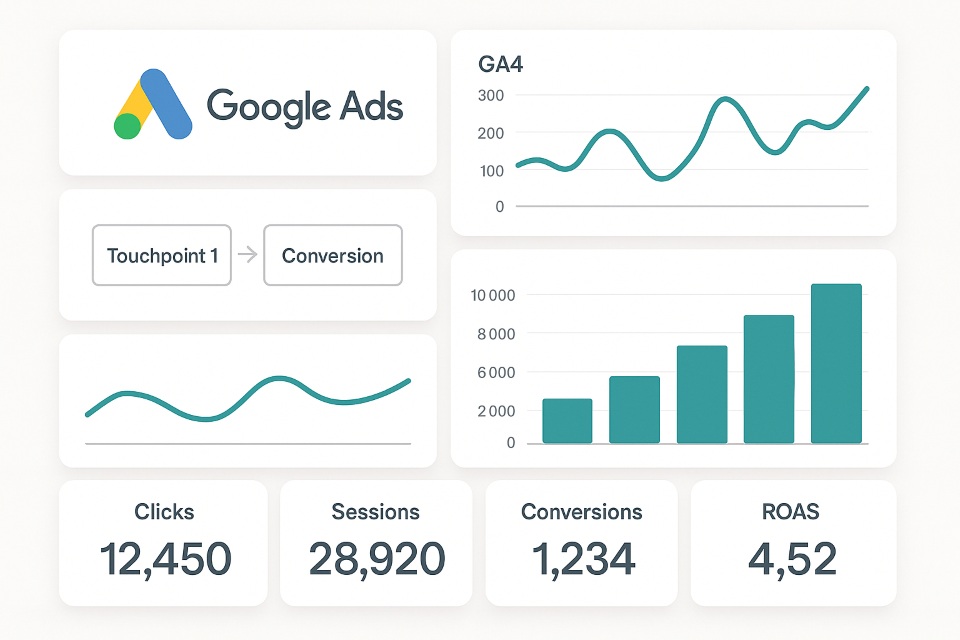
Key Takeaways
The main difference is that Meta shows you who engaged and how they behaved within its walls. Google shows you what they did next across the entire web.
So if you’re optimizing for attention and engagement, Meta’s in-platform analytics work beautifully. But if your goal is performance, ROI, and cross-channel insight, Google’s reporting stack is simply on another level.
Meta Ads Vs Google Ads: Scalability & Automation Potential
Scaling ads is where most campaigns either break or boom — and both Meta and Google have built automation systems to help you scale without losing efficiency. But the way they do it couldn’t be more different.
Meta Ads:
Meta Ads often rely on Advantage+ campaigns, CBO (Campaign Budget Optimization), and Dynamic Creative Testing. Meta’s automation thrives on pattern recognition and studies engagement behavior, learning what type of content, copy, and audience combination improves conversions. The more data you feed it, the more precise it gets.
However, Meta scaling requires patience. Push budgets too fast and you’ll reset the learning phase. Scale gradually, and Meta rewards you with lower CPMs and stronger ROAS.
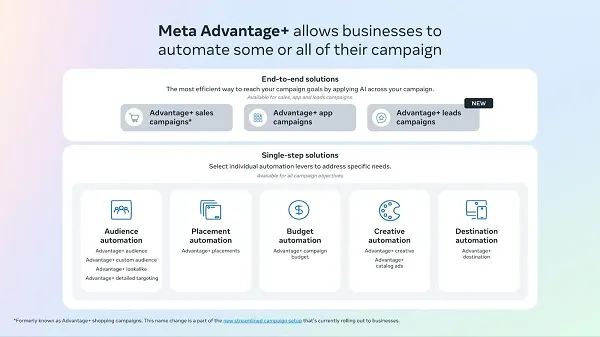
Google Ads:
Google Ads takes a more structured and information-rich route. Its automation suite (Smart Bidding, Responsive Search Ads, Performance Max, and Dynamic Search Ads) is designed for rapid scale across the entire Google ecosystem. Unlike Meta, Google doesn’t rely on social engagement signals; it uses intent data, conversion trends, and predictive modeling to allocate spend automatically to top-performing keywords, audiences, or placements.
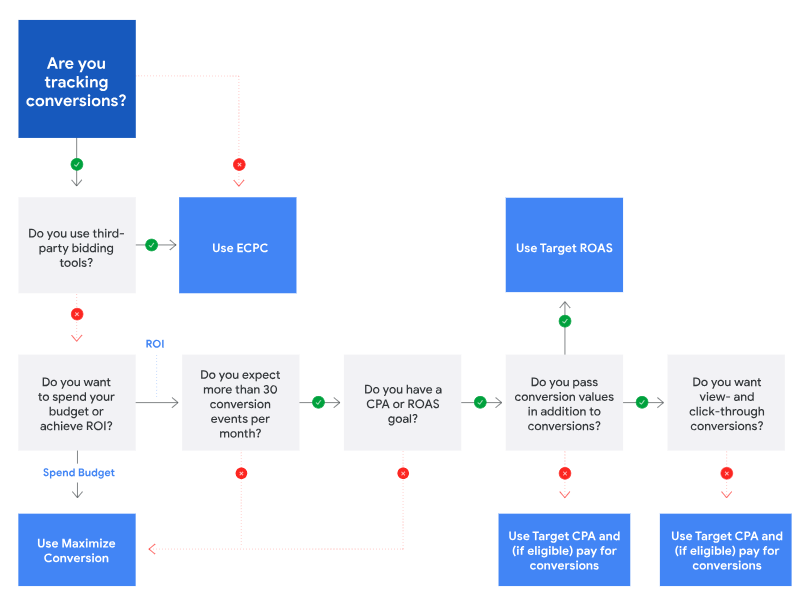
Key Takeaways
- Meta’s automation learns from who interacts with your content.
- Google’s automation learns from what converts
Both are incredibly powerful, but I’ve found that Google scales faster and more predictably, while Meta gives more creative flexibility and nuanced audience learning. If your goal is to dominate awareness and engagement, Meta’s automation is gold. But if you’re chasing conversion scaling, Google still wears the crown.
Summing Up
After running ad campaigns for years, I’ve learned one thing; it’s not about which platform is better, it’s about which one fits your goal.
If your brand relies on attention, storytelling, and visual discovery, Meta Ads wins hands down. It’s built for emotional resonance where visuals, community, and impulse combine. Meta’s data depth around interests and demographics gives you an edge for audience building, remarketing, and brand awareness campaigns.
But if your business revolves around search intent, lead quality, and measurable ROI, Google Ads is the clear choice. It aims for users who are already halfway down the funnel and are actively searching, comparing, or are ready to buy. Google’s ecosystem like Search, Display, YouTube, and Performance Max, connects every touchpoint with precision.
The way I see it:
- Meta Ads are like digital billboards. They make people want you.
- Google Ads are like a digital salesperson. They make people find you.
And the smartest marketers? They use both.
They build awareness and nurture interest on Meta, then capture that intent and close the loop on Google. That’s how the conversion magic happens, when your campaigns complement each other instead of competing.
So, don’t ask “Which platform should I use?”
Ask “Where in my customer journey does each platform make the most impact?”
That’s how you stop running ads and start building results.
